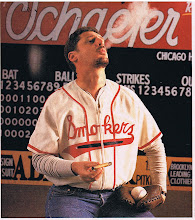
I was delighted to find out that one of my favorite sports movies of all times was finally released on DVD. "Kansas City Bomber" is a minor classic from 1972. It was a vehicle for Raquel Welch (she was the star as well as one of the producers). Welch also did her own skating and stunts for the film, which given the amount of action sequences in the movie is pretty impressive.
So...what's so great about this film, besides the undeniable charms of Raquel Welch in a durene roller derby jersey? First, it captures that great 70s ambiance that Will Ferrell and crew tried so hard to get right in "Semi Pro". The vibe is much more realistic here, given that this actually was filmed in the 70s. Roller Derby (or technically Roller Games, as Derby is a registered trademark) is a bit like professional wrestling: part sport and part spectacle. The dreary, badly-lit half-filled arenas, the, shall we say, unsophisticated fans, plus the great skating and fighting action, are all captured here. Names and uniforms of real Roller Games teams were used as well, an especially nice bit of realism for yours truly.
Welch plays Diane "K.C." Carr - a pretty divorcee and up-and-coming roller derby queen who leaves two young kids (one a very young Jodie Foster!) and a hostile mother behind to chase her dream, and get " a little piece of the action". Life on the Portland Loggers is far from ideal. She has to deal with the dark haired, brooding star she is hired to replace (wonderfully played by Helena Kallianiotes) who is not at all willing to be eclipsed by the more glamorous newcomer. She also has to contend with jealous teammates, lecherous fans, and a team owner (the very oily Kevin McCarthy) who takes more than a professional interest in her. The film also explores the compassionate relationship between K.C. and her maligned, slow-witted teammate "Horrible" Hank Hopkins (played here by Norman Alden in a performance that reminded me of the pathos of Charles Laughton in "The Hunchback Of Notre Dame". Really).
In addition to being a very good sports movie, the film has a subtle feminist message. Everyone wants a piece of K.C.: Her family, her boss, the fans. In the end she stakes a claim for herself.
This movie is usually considered a camp classic at best (o.k. there is one very gratuitous scene of Welch and Kallioniotes engaged in some hair-pulling and catfighting on railroad tracks in the light of an oncoming Union Pacific train, but who am I to complain?). I rate it a minor 1970s classic due to several very good performances, the excellent roller derby scenes, and the overall heart and intention of the film.
A little trivia for my fellow music fans: Phil Ochs was hired to write the theme song for the movie. The producers decided not to use it, but Ochs apparently issued it on one of his records. (I have not heard it, but would be interested in hearing from anyone who has). That's all from the dugout this week. Cheers.

